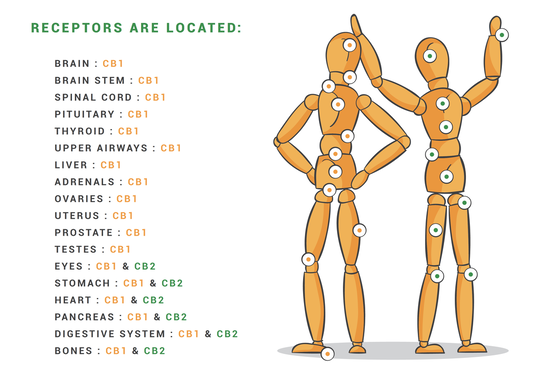The Human Endocannabinoid System
|
Hemp (or cannabis) has been used for thousands of years as food, fuel, fiber, and medicine. It wasn’t until the 1990’s, however, that the first endocannabinoids made in the body were discovered and the Endocannabinoid System (ECS) was confirmed.
Scientists were looking to find out more about the effects of tetrahydrocannabinol (THC) on our physiology when they discovered that was just the doorway into a whole new complex physiological system. According to the National Institutes of Health (NIH), the human body contains an endocannabinoid system, often called the “master regulator”, which is involved in “a host of homeostatic and physiologic functions, including modulation of pain and inflammation”.(1) This ECS is a network of neurotransmitters, called endocannabinoids, and their receptors distributed throughout entire body, brain, and nervous system that works continuously with all the other biological systems to promote homeostasis and overall good health. We are just now beginning to understand and explore the full potential of cannabinoids in treating a wide range of conditions. |
The ECS is involved in a variety of physiological processes, including:
|
How Does CBD Work?
|
These cannabinoid receptors are located throughout the body in nearly every organ and tissue, including the skin (the body’s largest organ). It’s believed they might be the most plentiful type of receptor in the human body.
While other receptor types are being studied and discovered(2), the two known primary receptors in the ECS are CB1 (mainly found in the brain and nervous system) and CB2 (primarily in the gut and immune system). The human body naturally produces its own internal cannabinoids, called endocannabinoids, that work with these cannabinoid receptors. CBD extracts and other cannabinoids from plants, called phytocannabinoids, also fit into the receptors of our endocannabinoid system. It’s believed that these supplemental phytocannabinoids compliment and help us better utilize our own internally produced endocannabinoids, thereby assisting the body’s efforts to maintain homeostasis and keep us healthy. Because the ECS is so widely distributed and inter-meshed with all of our other biological functions, researchers are studying CBD and other cannabinoids for a wide range of uses and conditions. |
|
Back << What is CBD & Hemp Extract? Next >> CBD Benefits & Research
*These statements have not been evaluated by the Food and Drug Administration. This product is not intended to diagnose, treat, cure or prevent any disease.
(1) Fine PG, Rosenfeld MJ. The endocannabinoid system, cannabinoids, and pain. Rambam Maimonides Med J. 2013;4(4):e0022. Published 2013 Oct 29. doi:10.5041/RMMJ.10129 https://www.ncbi.nlm.nih.gov/pmc/articles/PMC3820295
(2) Sharir H, Abood ME. Pharmacological characterization of GPR55, a putative cannabinoid receptor. Pharmacol Ther. 2010;126(3):301–313. doi:10.1016/j.pharmthera.2010.02.004 https://www.ncbi.nlm.nih.gov/pmc/articles/PMC2874616
(3) Alger BE. Getting high on the endocannabinoid system. Cerebrum. 2013;2013:14. Published 2013 Nov 1. https://www.ncbi.nlm.nih.gov/pmc/articles/PMC3997295/
(2) Sharir H, Abood ME. Pharmacological characterization of GPR55, a putative cannabinoid receptor. Pharmacol Ther. 2010;126(3):301–313. doi:10.1016/j.pharmthera.2010.02.004 https://www.ncbi.nlm.nih.gov/pmc/articles/PMC2874616
(3) Alger BE. Getting high on the endocannabinoid system. Cerebrum. 2013;2013:14. Published 2013 Nov 1. https://www.ncbi.nlm.nih.gov/pmc/articles/PMC3997295/

